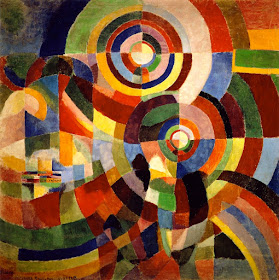Made the journey to Tate Modern to see this Delaunay retrospective. I didn't know too much about her life/work apart from her marriage to Robert Delaunay and her colourful abstract paintings of concentric circles, and some of the graphic/typographic work that she had collaborated on with the poet Blaise Cendrars.
Delaunay's early figurative work was influenced by Gauguin and displayed a clear love of colour. It was only after meeting and marrying Robert Delaunay that they developed and applied the theory of simultaneous colour contrasts - Simultanism, to their work that Delaunay abandoned figurative art and embraced total abstraction. The creation of the patchwork quilt below, for her son was key to the future direction of her art and application of simultanism to other disciplines such as fashion, textiles and graphic design. I loved the roughness and obvious hand-made qualities of the quilt, and also a patchwork dress that she wore, and a patchwork waistcoat in the exhibition.
Also key to her simultaneous theories were technological advances in the early twentieth century such as the installation of electric lighting on the streets of Paris, and the 'halo' effect of colours these new street lights displayed. These were explored in her Electric Prisms series, below. The effects of rhythm, movement and colour were also explored on canvas, courtesy of the craze for the tango which swept Parisian dance halls in paintings like that below.
I really enjoyed seeing Delaunay's application of simultanism to graphic design and typography. Again it was the relatively unsophisticated and obviously hand-drawn qualities that I admire, and the fact that her hand-drawn type flows freely and doesn't fit neatly into a grid. The playfulness and experimentation of the illustrative typography on the Vogue cover below is great, but would not necessarily sell many copies on todays newsstands without the requisite supermodel/celebrity on the cover.
Typography and words obviously excited Delaunay from her collaborations with poets such as Cendrars and Tzara, and there is also evidence from photographs of her apartment where she would paint poetry on doors to create what she termed 'door-poems'. This idea was developed further and given movement with the application of text to fabrics in Delaunay's fashion designs for her Dress-Poem series. I would really have liked to see actual examples of these dresses in the exhibition.
It was whilst living in Spain having fled Paris because of the First World War, and finding herself in straitened circumstances that Delaunay was forced to put all of her artistic efforts into applied art. She opened a shop - Casa Sonia, from which she sold simultaneous printed fabrics, furniture, clothes and accessories. The shop was hugely successful and other branches were opened in other cities. It was the application of her work to other disciplines which was to enable her to fund and develop her abstract painting. Delaunay embraced working across a variety of disciplines and continued to design textiles, clothing and accessories on her return to Paris with husband Robert in 1921. I really like the fact that her work could be and was, adapted for and applied to a variety of surfaces. Delaunay is an important figure in that she broke down the distinctions between the fine and applied arts so successfully. She is shown on the cover of Vogue by illustrator Georges Lepape, in one of her dress designs with a motor car painted in the simultaneous style.
These are examples of some of Delaunay's geometric textile work which remind me of the designs on moquette fabrics seen on London Transport.
In terms of colour and style Delaunay has clearly left a legacy subconsciously or perhaps more deliberately on textile and fashion designers, (to be explored in a further post), and also contemporary artists like Bridget Riley and Beatrice Milhazes. It would be great to see a group exhibition of women artists who's work is based around the use of abstraction and colour.
I took much away from this exhibition in terms of potential for future development in my own work. It made me aware of other possibilities which remain to be explored. I felt really uplifted by the colour and rhythmic qualities of Delaunay's work, and recommend a visit to this exhibition.
Sonia Delaunay
until 9th August 2015
Tate Modern
Bankside
SE1












































